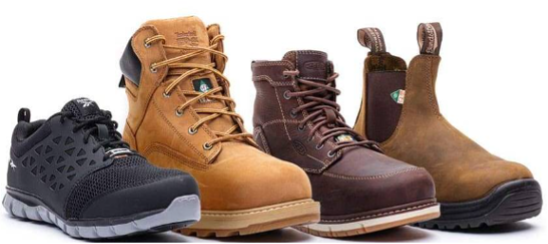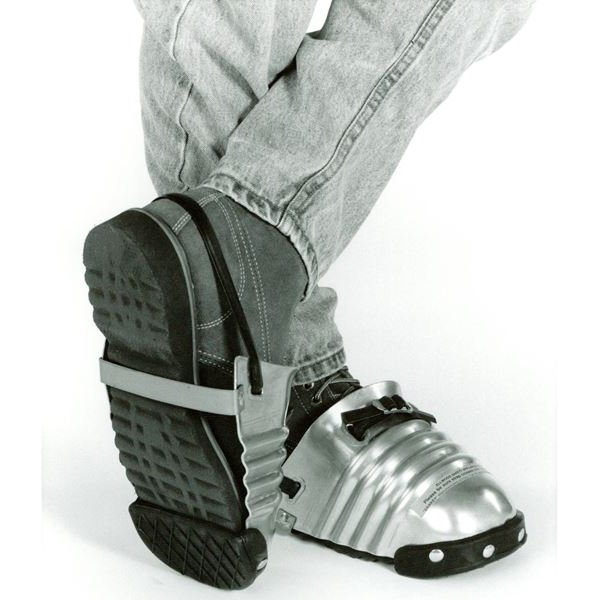Many types of protective footwear are available for work involving toe and foot hazards. Some are designed for work in a specific craft or industry, such as fire fighters, electricians or machinists. Others provide a specific type of protection from hazards such as crushing, impact, or electrical shock. Many footwear options offer combined protection.

When are "safety" shoes required?
Safety shoes are required when there is a risk of injury to the feet while performing work on the job. When it is not feasible to eliminate the risk of foot injuries due to the type of work being performed or its location, foot protection may be the most effective method of preventing foot injuries.
Foot protection must be worn when working in areas where there is a danger of foot injuries to reduce the risk of injury from
- falling or rolling objects,
- objects piercing the sole,
- hazardous chemical spills,
- or when the use of protective footwear will protect the affected employee from an electrical hazard, such as a static-discharge or electric-shock.
Protective Footwear at SF State
"Safety Shoes" are typically required to have a leather upper, have oil resistant and non-skid soles and offer impact and crushing protection. Other features designed to protect the feet from specialty work hazards are required as well if these hazards are present. For example, non-conductive soles for electricians and metatarsal (top of foot) protection for construction or shipping workers where heavy drums or items can fall or roll.
Cal/OSHA 8 CCR 3385, Foot Protection Standard
Protective footwear purchased for employees must meet the requirements and specifications in American Society for Testing and Materials (ASTM) F 2412-05, Standard Test Methods for Foot Protection and ASTM F 2413-05, Standard Specification for Performance Requirements for Foot Protection.
Appropriate foot protection shall be required for employees who are exposed to foot injuries from electrical hazards, hot, corrosive, poisonous substances, falling objects, crushing or penetrating actions, which may cause injuries or who are required to work in abnormally wet locations.
Footwear which is defective or inappropriate to the extent that its ordinary use creates the possibility of foot injuries shall not be worn.
Enterprise Risk Management manages the slip resistant shoes program with Shoes Crews. Slip-resistant shoes are intended to prevent slips and falls. Since they do not to protect the foot from injury, they are NOT considered safety shoes.
Note: Slip-resistant shoes purchased from Shoes for Crews that also meet the criteria for "safety shoes" are, by definition, safety shoes.
For more information about this program, go to the Shoes for Crews web page.
Standard Safety Shoes
Maximum Reimbursement Amount: $120
Basic safety shoes must have all of the protective features below:
- Steel or composite toe guards with an impact resistance rating of 75 and compression rating of 75
- Dense soles to protect from sharp objects on walking surfaces
- Soles with good traction and slip resistance
- Leather uppers (other treated material may be permitted with written EHS approval)
- Designed for comfortable walking
Enhanced Safety Shoes
Maximum Reimbursement Amount: $185
Basic safety shoes have the protective features listed above and include one or more of these additional protective features.
- 6” – 8” Lace-up upper that extends beyond the ankle
- Waterproof
- Metatarsal protection
- Notched heel
- EH rated rubber or other non-conductive sole
- Oil-resistant or chemical-resistant soles
- Metal insoles for puncture hazards
General fund and career employees are eligible for employer-provided safety shoes if a hazard assessment determines that a risk of serious injury to the feet could arise from job duties.
Temporary workers, such as student assistants and graduate assistants, are usually not eligible for this program. However, exceptions can be made for certain cases. Instead, temporary foot protective devices should be made available for specific tasks that require foot protection but are only performed occasionally.
To request safety shoes, contact your supervisor or department.
- The supervisor or department can perform a hazard assessment, such as a job hazard analysis (JHA) or request assistance from EH&S.
- If the department determines that the task cannot be re-engineered to reduce the risk or be eliminated entirely, then safety shoes may be appropriate.
All required protective footwear must be paid for by the employee’s college, department, or unit, or by a grant, project, or another funding source.
Example of a temporary foot protective device that can be worn over regular shoes.

Employer-Required PPE
If an employer requires safety shoes or other PPE to be worn at work, then the employer is required to pay for the PPE.
At SF State, all required protective footwear intended to comply with Cal/OSHA safety standards, must be paid for by the employee’s college, department, or unit, or by a grant, project, or another funding source.
Employer-Required Dress Code
An employer can require a dress code to be worn on the job, such as closed-toe shoes, long sleeves, long pants, black pants, black shoes, sneakers with rubber soles, etc.. The employer is not required to pay for this type of clothing or footwear.
Foot hazards in these areas are generally not severe enough to require safety shoes. Appropriately protective footwear in SFSU labs and art studios is part of an employer-required dress code at SFSU.
Shoes like sandals, Crocs, flip flops, and soft ballet-style slippers offer little or no protection from unexpected spills or dropped items and are inappropriate in labs or art studios that use hazardous materials or equipment.
Quick Links
University Personal Protective Equipment Written Program (link is pending)
Back to main Personal Protective Equipment web page